|


from
PrisonPlanet Website
2 January 2005
Recently re-discovered photos depicting scenes from early 20th
century Bohemian Grove gatherings appear to contradict official
claims that a 'mock' sacrifice is made and that real humans have
never been sacrificed in the ritual.
These photos originally appeared on the
Berkeley University of
California website, which is often used as a mouthpiece for the
Bohemian Grove Club.
See full
Photo Galley dated 1906 - 1909
CLICK PHOTOS FOR ENLARGEMENTS
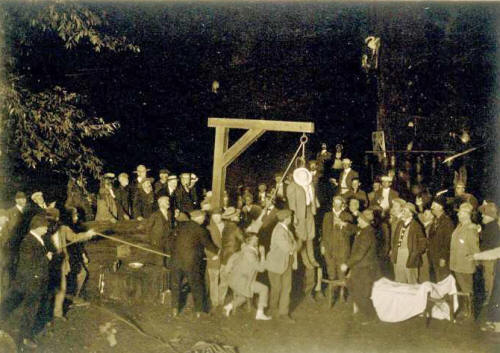
The first photograph appears to show a
lynching or public execution.
If the body is a mannequin it is certainly very authentic. Click to
see the enlargement, judging by the look of the hand this is a real
person.
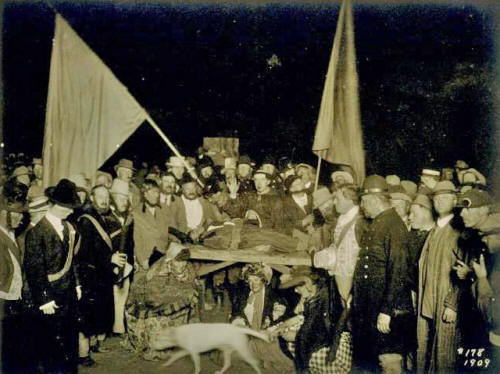
There can be little doubt about the second photo. The person is
clearly a black child or a midget. He is strapped down on a board.
One of the figures in the foreground appears to be a policeman. The
picture is dated 1909.
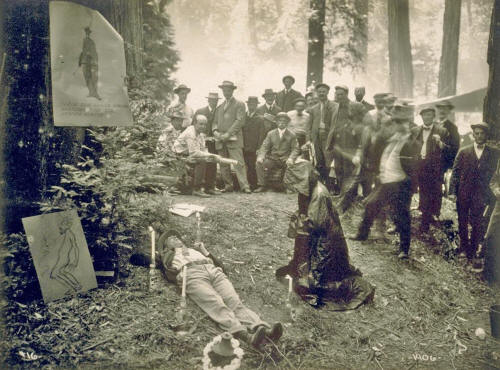
An old photo from Bohemian Grove on the
National Geographic website
appeared with the following caption:
Power Party
Photograph by
Gabriel Moulin, 1915
To purge himself of worldly concerns, a member of the elite
Bohemian
Club participated in a 1915 Cremation of Care ceremony - complete with
candles and a robed and hooded comrade to guide him.
This private
club of influential men still meets annually north of San Francisco
and uses this symbolic ritual to kick off its summer retreat. But
today the ceremony involves burning a mummy-like effigy named
Care
at the foot of the group's mascot: a 40-foot-tall (12-meter-tall)
concrete owl.
One of the ancient and now well researched Canaanite deities that
was and still is worshipped by the 'Brotherhood' is often symbolized
as an owl and is referred to as Molech (sometimes Moloch).
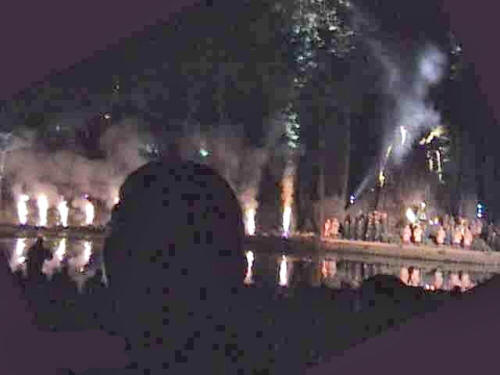
In July 2000 Alex Jones successfully
infiltrated Bohemian Grove and
documented the Cremation of Care sacrificial ceremony. For full
details,
click here.
The ceremony includes a ritualistic 'mock' sacrifice in worship of
Molech, which is represented by a 40-50 foot horned statue (seen
above).
From the Jewish Encyclopedia
Moloch
(Hebrew Molech, king).
A divinity worshipped by the idolatrous Israelites. The Hebrew
pointing Molech does not represent the original pronunciation of the
name, any more than the Greek vocalization Moloch found in the LXX
and in the Acts (vii, 43). The primitive title of this god was very
probably Melech, "king", the consonants of which came to be combined
through derision with the vowels of the word Bosheth, "shame". As
the word Moloch (A.V. Molech) means king, it is difficult in several
places of the Old Testament to determine whether it should be
considered as the proper name of a deity or as a simple appellative.
The passages of the original text in which the name stands probably
for that of a god are Lev., xviii, 21; xx, 2-5; III (A. V. I) Kings,
xi, 7; IV (II) Kings, xxiii, 10; Is., xxx, 33; lvii, 9; Jer., xxxii,
35.
The chief feature of Moloch's worship among the
Jews seems to
have been the sacrifice of children, and the usual expression for
describing that sacrifice was "to pass through the fire", a rite
carried out after the victims had been put to death. The special
centre of such atrocities was just outside of Jerusalem, at a place
called Tophet (probably "place of abomination"), in the valley of
Geennom.
According to III (I) Kings, xi, 7,
Solomon erected "a
temple" for Moloch "on the hill over against Jerusalem", and on this
account he is at times considered as the monarch who introduced the
impious cult into Israel. After the disruption, traces of Moloch
worship appear in both Juda and Israel. The custom of causing one's
children to pass through the fire seems to have been general in the
Northern Kingdom [IV (II) Kings, xvii, 17; Ezech. xxiii, 37], and it
gradually grew in the Southern, encouraged by the royal example of
Achaz (IV Kings, xvi, 3) and Manasses [IV (II) Kings, xvi, 6] till
it became prevalent in the time of the prophet Jeremias (Jerem.
xxxii, 35), when King Josias suppressed the worship of Moloch and
defiled Tophet [IV (II) Kings, xxiii, 13 (10)]. It is not improbable
that this worship was revived under Joakim and continued until the
Babylonian Captivity.
On the basis of the Hebrew reading of III (I) Kings, xi, 7,
Moloch
has often been identified with Milcom, the national god of the
Ammonites, but this identification cannot be considered as probable:
as shown by the Greek Versions, the original reading of III (I)
Kings, xi, 7, was not Molech but Milchom [cf. also III (I) Kings,
xi, 5, 33]; and according to Deut., xii, 29-31; xviii, 9-14, the
passing of children through fire was of Chanaanite origin [cf. IV
(II) Kings, xvi, 3].
Of late, numerous attempts have been made to
prove that in sacrificing their children to Moloch the Israelites
simply thought that they were offering them in holocaust to Yahweh.
In other words, the Melech to whom child-sacrifices were offered was
Yahweh under another name. To uphold this view appeal is made in
particular to Jer., vii, 31; xix, 5, and to Ezech., xx, 25-31. But
this position is to say the least improbable.
The texts appealed to
may well be understood otherwise, and the prophets expressly treat
the cult of Moloch as foreign and as an apostasy from the worship of
the true God. The offerings by fire, the probable identity of
Moloch
with Baal, and the fact that in Assyria and Babylonia Malik, and at
Palmyra Malach-bel, were sun-gods, have suggested to many that
Moloch was a fire- or sun-god.
MOLOCH (MOLECH).
by Isidore Singer George A. Barton
- Biblical Data:
In the Masoretic text the name is "Molech"; in the Septuagint
"Moloch." The earliest mention of Molech is in Lev. xviii. 21, where
the Israelite is forbidden to sacrifice any of his children to
Molech. Similarly, in Lev. xx. 2-5, it is enacted that a man who
sacrifices his seed to Molech shall surely be put to death. Then,
curiously, it is provided that he shall be cut off from the
congregation.
In I Kings xi. 7 it is said that Solomon built a high
place for Molech in the mountain "that is before Jerusalem." The
same passage calls Molech an Ammonite deity. The Septuagint as
quoted in the New Testament (Acts vii. 43) finds a reference to
Moloch in Amos v. 26; but this is a doubtful passage. In II Kings
xxiii. 10 it is stated that one of the practices to which Josiah put
a stop by his reform was that of sacrificing children to Molech, and
that the place where this form of worship had been practiced was at
Topheth, "in the valley of the children of Hinnom." This statement
is confirmed by Jer. xxxii. 35.
From II Kings xxi. 6 it may be
inferred that this worship was introduced during the reign of
Manasseh. The impression left by an uncritical reading of these
passages is that Molech-worship, with its rite of child-sacrifice,
was introduced from Ammon during the seventh century B.C.
Nature of the Worship
- Critical View:
The name "Molech," later corrupted into "Moloch," is an intentional mispointing of "Melek," after the analogy of "bosheth" (comp.
Hoffmann in Stade's "Zeitschrift," iii. 124). As to the rites which
the worshipers of Molech performed, it has sometimes been inferred,
from the phrase "pass through the fire to Molech," that children
were made to pass between two lines of fire as a kind of
consecration or februation; but it is clear from Isa. lvii. 5 and
Jer. xix. 5 that the children were killed and burned. The whole
point of the offering consisted, therefore, in the fact that it was
a human sacrifice.
From Jer. vii. 31 and Ezek. xx. 25, 26, it is
evident that both prophets regarded these human sacrifices as
extraordinary offerings to Yhwh. Jeremiah declares that Yhwh had not
commanded them, while Ezekiel says Yhwh polluted the Israelites in
their offerings by permitting them to sacrifice their first-born, so
that through chastisement they might know that Yhwh was Yhwh. The
fact, therefore, now generally accepted by critical scholars, is
that in the last days of the kingdom human sacrifices were offered
to Yhwh as King or Counselor of the nation and that the Prophets
disapproved of it and denounced it because it was introduced from
outside as an imitation of a heathen cult and because of its
barbarity. In course of time the pointing of "Melek" was changed to
"Molech" to still further stigmatize the rites.
Motive of Sacrifices
The motive for these sacrifices is not far to seek. It is given in
Micah vi. 7: "Shall I give my first-born for my transgression, the
fruit of my body for the sin of my soul?" In the midst of the
disasters which were befalling the nation men felt that if the favor
of Yhwh could be regained it was worth any price they could pay.
Their Semitic kindred worshiped their gods with offerings of their
children, and in their desperation the Israelites did the same.
For
some reason, perhaps because not all the priestly and prophetic
circles approved of the movement, they made the offerings, not in
the Temple, but at an altar or pyre called "Tapheth" (LXX.), erected
in the valley of Hinnom (comp. W. R. Smith, "Rel. of Sem." 2d ed.,
p. 372). "Tapheth," also, was later pointed "Topheth," after the
analogy of "bosheth." In connection with these extraordinary
offerings the worshipers continued the regular Temple sacrifices to
Yhwh (Ezek. xxiii. 39).
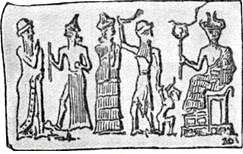
Babylonian Cylinder Representing Sacrifice of a Child
(From Menant, "Glyptique Orientale")
From the fact that I Kings xi. 7 calls
Molech the "abomination of
the children of Ammon" it was formerly assumed that this worship was
an imitation of an Ammonite cult. But so little is known of the
Ammonite religion that more recent scholarship has looked elsewhere
for the source. Because of the mention in II Kings xvii. 31 of
Adrammelech (= Adar-malik) and Anammelech (=Anu-malik) as gods of
Sepharvaim transplanted to Samaria, it has been inferred that this
form of worship was borrowed from Babylonia (comp. Bäthgen, "Beiträge
zur Semitischen Religionsgesch." pp, 238 et seq.).
This view rests
on the supposition that "Sepharvaim" is equal to "Sippar," which
probably is not the case. Even if it were, Anu and Adar were not
gods of Sippar; Shamash was god of that city. From this verse,
therefore, a Babylonian or Assyrian origin can not be demonstrated.
Support for this view has been sought also in Amos v. 26. If, as is
probable, Siccuth and Chiun in that passage are names or epithets of
Babylonian deities (comp. Chiun), the use of "Melek" in connection
with these affords no sound basis for argument. The whole passage
may be, as Wellhausen and Nowack believe, a late gloss introduced on
account of II Kings xvii. 31, and is in any case too obscure to
build upon.
Furthermore, there is no evidence that the sacrifice of
the first-born was a feature of the worship of Babylonian deities.
Because child-sacrifice was a prominent feature of the worship of
the Phenician Malik-Baal-Kronos, Moore (in Cheyne and Black, "Encyc.
Bibl.") seeks to prove that the worship of Moloch was introduced
from Phoenicia. The evidence of its existence in Phoenicia and her
colonies is especially strong. Diodorus Siculus (xx. 14) tells how
the Carthaginians in a siege sacrificed two hundred boys to
Kronos.
Burning was an important feature of the rite.
Bibliography:
-
W. R. Smith, Rel. of Sem. 2d
ed., pp. 372 et seq.
-
Bäthgen, Beiträge zur Semitischen Religionsgesch. 1888, pp. 237 et
seq.;
-
Moore, The Image of Moloch, in Jour. Bib. Lit. 1897, xvi. 161 et
seq.;
-
M. J. Lagrange, Etudes sur les Religions Sémitiques, 1903, pp.
99-109.S.
-
Moloch - Demonology - A Gallery of Demons Historical account of
demonology and evil in
http://www.deliriumsrealm.com/delirium/mythology/moloch.asp
Further depictions of Molech
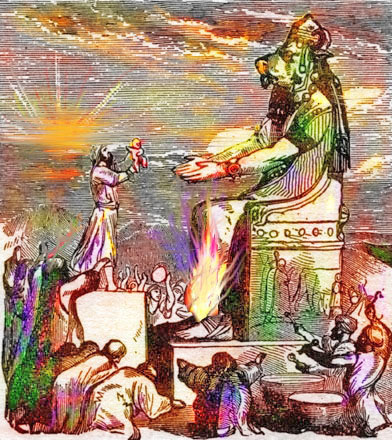
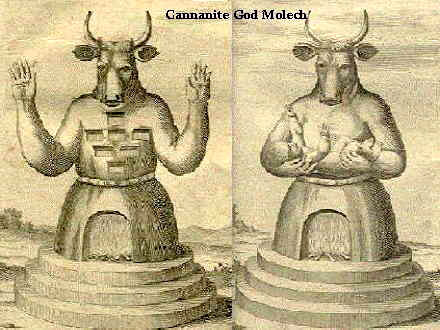
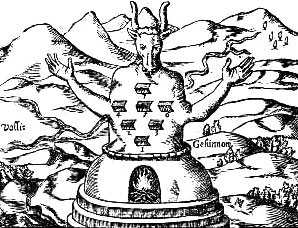
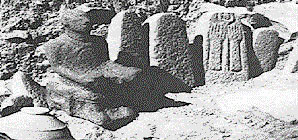
|








